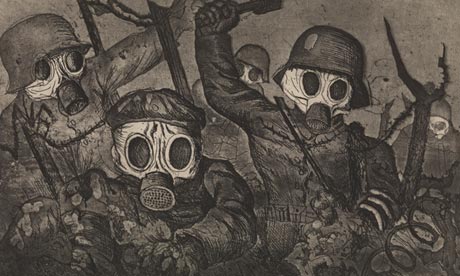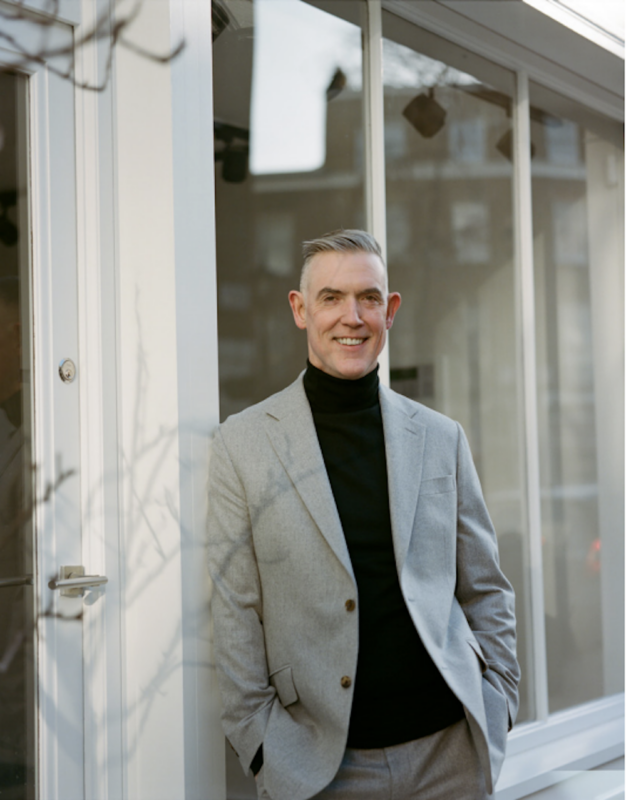
Otto Dix’s Shock Troops Advance Under Gas (1924). Photograph: The Richard Harris Collection/Death: Wellcome Collection
What does Death look like? He is a dapper gent in evening dress, arriving late to the party. He is a skull in a hood with a scythe. He is a shadowy figure stealing past the window – your window – or a skeleton in a dark cloak with an hourglass, perhaps even playing upon a bony violin. Why, everybody knows what He looks like.
Except that we do not, of course; for there are no images until artists become involved. Unlike writers, who can personify Death merely by using a capital letter, artists have to give Him some sort of appearance.
This may be semi-abstract, as in Goya’s etching of a corpse hauling himself back out of the grave to point at the single dire word Nada – nothing – written on a sheet of paper. Or it may be forcefully figurative, as in Dürer’s Four Horsemen of the Apocalypse thundering along with savage glee, pitchforking the living into oblivion.But either way it requires a narrowing of focus, some sense of definition or form, perhaps even a face by which Death may be recognised, feared or confronted.
This personification is the subject of a tremendous show opening at the Wellcome Collection this week, which includes Dürer, Goya and many other death-depicting artists in its wide and sometimes frightening array. Death: A Self-Portrait has the famous war etchings of Jacques Callot, where the garrotted bodies dangle from distant trees like dead crows on a wire. It has works by Hogarth, Ensor and Warhol. It has the dark visions of Otto Dix.
There are also curiosities galore, including a bone chandelier in which femurs, clavicles and wrists seem to emulate the clinking of crystal in their awful swaying music; an ivory tusk carved with Dürer’s Horsemen; a lacework of autopsy drawings turned into a vast doily and a whole cake-stand of porcelain figurines of dancing couples in which one partner is hale and hearty and the other pale and skeletal but still dancing merrily towards death. These were adored by 19th-century Germans.
Indeed this seems like a very northern European show at the start – all those gothic memento mori and protestant warnings against vanity and vice. The monkey preening in the mirror while Death creeps up behind him; the bubble-blowing toddler resting one dimpled Dutch hand on a skull. But there are universalities (what else?) with Death, so that the skeletons dancing across Kyõsai’s fabulous Japanese watercolours – leaping, whirling, flying – reappear in the wooden Tibetan icons got up in pleated skirts and apparently performing the Highland fling.
And though there is a strong religiosity to the earlier works, when Death carries scales to weigh our souls, this eventually turns to secular morality. The rich man and the poor will die alike. A life well lived is a force against Death. In Thomas Chambers’s two-part print, the good man is tucked up in bed, untroubled by his conscience as a kindly Death arrives on wings; while the bad man, wine glass overturned, foot swollen with gout, is absolutely terrified at the hint of a shadow.
But some of these works reveal a weirder fascination with death, as in the photograph of Victorian anatomists with a flayed corpse beneath the whimsical caption “when will we meet again?”; or the charnel house of Ex Libris plates in which skulls are depicted wearing laurels or nightcaps while silently mouthing the words of their bedtime reading.
Gallows humour shades into something altogether more sinister, though, in the bizarre Antikamnia calendars featuring cowboy, clown and banjo-playing skeletons. Spryly drawn by Louis Crucius in the 1890s for an American pharmaceutical firm, these images must surely be among the very few dead-heads ever used in advertising; in this case a painkiller which, by coincidence, turned out to be fatally toxic.
If death has an embodiment, so to speak, it is the skeleton over and again, that pale surrogate that lives inside us all. Skeletons look good in prints (the works in this show all belong to the American print collector Richard Harris) being so black and white and linear, no flesh to differentiate, no character beyond their sharp articulations, like three-dimensional drawings.
Two of the most striking works here apply flesh to bone. A portrait of a French soldier shows him vertically bisected: bodied forth on one side, skeletal on the other. It is one thing (and strange enough) to have yourself painted, quite another to contemplate your death in the same image; though such intimations of mortality are perhaps implicit in photographic portraits.
James Ensor catches sight of Death in an extraordinary self-portrait in which he appears to be both vividly alive and yet melting away. The head is dwindling to cranial bone, the eye sockets are emptying as you look. What’s remarkable is that, despite this degeneration, the likeness is perfectly sustained. Death shall have no dominion.
One experiences this art – as so often at the Wellcome Collection, and so rarely elsewhere – in the most visceral ways. Revulsion, anxiety, uneasiness, sorrow, perhaps shock, certainly awe: the etchings of Otto Dix, for instance, inspire them all. The climax of the show is a death wall of black-edged prints in which figures rush to escape Death in the form of warplanes, hooks or obliterating black flags descending from the clouds.
Dix’s Death is the great war itself. He imagines what it might be like to die beneath collapsing buildings, in cellars, in soil; he himself knew what it was like to eat scraps in the trenches alongside the yawning mouth of a corpse. He sees the skull in a gas mask, and the teeth-chattering conversations that seem to continue between two sets of lifeless mandibles. Saddest of all, he draws the inchoate form curled up dead in a pit, dark inversion of the beginning of life.
Dix’s pictorial ideas appear endless, as unparalleled in his time as Goya before him. If it were not for this teeming inventiveness it would be hard to keep looking, stilled as one is by the horror. So it is almost a relief to come upon the eccentric anonymous photographers of the 19th century who took a brave look at Death, not quite in the face but from a semi-humorous angle, appearing with a skeleton as one of their number.
Why would anyone collect such images? Harris has said that it is his way of making peace with Death. But the show is presumably his own self-portrait, I suppose, revealing a man who keeps on trying to look Death in the eye. But Death has no eyes, no face, no personality. Death is only death, after all, an event in the sequence of life. All of the artists in this show are bent on giving it a face but in the end its blankness is most perfectly represented by the German artist George Grosz in a small collage of figures – young and old, male and female, the whole lot of us, in short – each with the same bright skull for a head.
It is both solemn and jaunty, this little jeu d’esprit, as if to say that we’re all in this together. And Grosz has added an extra skull beneath the sole of a well polished shoe: step forward and tread on death.
• This article was amended on 12 November 2012. The original text referred to the Wellcome Institute, rather than the Wellcome Trust throughout and has been corrected.
guardian.co.uk © Guardian News & Media Limited 2010
Published via the Guardian News Feed plugin for WordPress.









